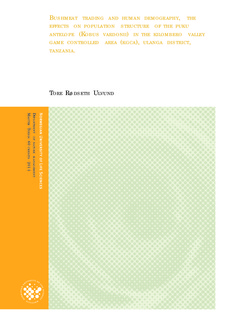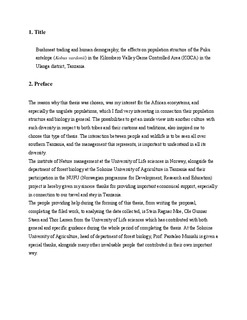| dc.description.abstract | The background for this thesis is the NUFU (Norwegian programme for Development, Research and Education) project “integrating livelihoods and multiple biodiversity values in wetlands management in Tanzania” which is a research project where the assessment of biodiversity, among several other studies, was assessed during the fall of 2008. The Kilombero Valley houses about 75% of the remaining populations of Puku antelope (Kobus vardoni) in the world, and the populations are being hunted unsustainably (Corti, G. R. et al. 2002), alongside high populations of buffalo (Syncerus caffer) and elephant (Loxondonta africana), these are some of many charismatic and important species residing in the Valley, (Bonnington, C. et al. 2007). The objectives of the study was to Find an overview of the legal harvest, thereby hunting quotas in the Ulanga district in the Kilombero Valley, Find the extent of illegal harvest in the villages neighbouring the two study areas and to study the population structure of puku antelope in two study areas in the actual annually inundated floodplain, inside and outside a hunting concessionary. This was looked at in relation to both density of humans in neighbouring villages, and data on bushmeat trade in the villages. This was not quantitative, but some assumptions could be made to analyze the tendencies found in the answers from the questionnaires. The study site was situated in the Ulanga district in the Morogoro region, in the KGCA (Kilombero Game Controlled Area). The study area is a part of the Kilombero Valley Floodplain, located in the South-eastern part of Tanzania. One picked 20 more or less randomly chosen transects, 10 inside the hunting concessionary of Wild footprint Ltd., and 10 transects outside the hunting concessionary. Both study areas wore inside the KGCA boundaries. One drove and assessed all transects with an SUV three times, where all ungulates wore assessed. After the field work, puku antelope was picked as the studied species for the thesis because of the amount of data. One also made the assumption that one could on average see 400m out on each side of the vehicle, and that about as many puku that wore assessed, wore also not assesses, and all data was multiplied by 2. The presence of a hunting concessionary inside the KGCA, seems to impact the populations of puku antelope in a positive way compared to areas of the KGCA that are not inside a hunting concessionary. Line transects wore used as a way of estimating the structure of puku antelope in the two study areas, one inside a hunting concessionary run by Wild footprint Ltd which was located west of the village of Itete, the other further north but still inside the KGCA. The results on population structure of puku antelope and numbers, showed a skewed sex ratio of adults inside the hunting concessionary showed 30 % males and 70 % females. In the southern study area this ratio was 48 % males and 52 %. This could suggest that trophy hunting does exist to some degree inside the hunting concessionary. The ratio of females and juveniles overall wore skewed towards females, in fact the number females was double that of juveniles. This could suggest some form of stress upon females, perhaps leading to lower birth ratios then in areas with lower stress in general. The bushmeat data collected and analyzed suggests that bushmeat trading exists at a relatively high scale, and that the possible economic revenue is present if bushmeat could instead, first be sold as hunting quotas. The seemingly low estimates of bushmeat trading of puku, suggest a possible total economic loss (N=78 puku) of 46.800.00, - Tanzanian shillings (TSH). The general assumption that the methodology used in this thesis could be different from earlier studies and that the density measures of puku could be different than in other studies, could be criticised and be subjected to scrutiny. | no_NO |

